Development teams are under constant pressure to deliver more, faster. But speed alone doesn’t guarantee success. When engineering, business, and leadership teams aren’t aligned, projects stall, backlogs pile up, and the end product often falls short of customer expectations. The result is friction that slows delivery and weakens confidence across the organization.
Agile offers a proven way to overcome these challenges. It’s not a rigid set of rules but a flexible framework built on values that prioritize customer needs, team collaboration, and adaptability. By focusing on outcomes over processes, Agile empowers teams to shape workflows that fit their goals and deliver results with confidence.
In this article, we’ll break down the 12 principles behind Agile, explore how they can help your team move faster and stay aligned, and share practical tips for putting them into action. Understanding these fundamentals is the first step toward building a more responsive and effective development culture.
Key takeaways
- Prioritize customer satisfaction and frequent delivery to see immediate results. These two principles lay the foundation for everything else and create quick wins that build momentum.
- Encourage daily collaboration between business and development teams to break down silos. This helps prevent misaligned priorities and reduces wasted effort on features customers don’t need.
- Leverage tools that support flexible workflows and real-time visibility to make Agile principles easier to adopt. With monday dev, teams can customize processes and stay aligned without relying on constant meetings.
- Adopt Agile principles gradually by implementing two or three at a time. Start with the ones that directly address your team’s biggest pain points to avoid overwhelm.
- Measure success by working software and customer outcomes rather than hours logged or tasks completed. This keeps the focus on delivering meaningful value instead of busy work.
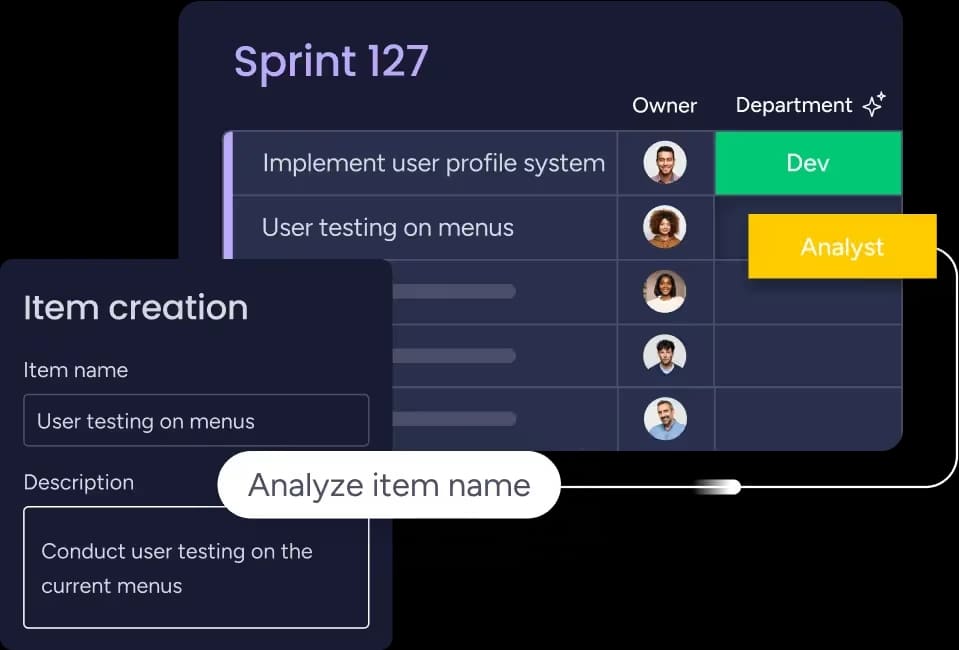

"monday dev empowered us to optimize our GTM approach, resulting in faster, more dependable deliveries"
Steven Hamrell | Director of Product Management
"monday dev empowers us to manage the entire development process on one platform so we can speed up product delivery and improve customer satisfaction"
Mitchel Hudson | Head of Technology
"We're operating in an open, deep trusting, transparent environment with no silos of information. It's about completely opening access to everyone who needs it."
Alan Schmoll | Executive Vice President, Vistra PlatformWhat are Agile principles?
Agile principles are a set of 12 guidelines from the Agile Manifesto that help development teams deliver more value to customers. A 2024 study in the International Journal of Project Management found that Agile projects achieve significantly more favorable outcomes compared to traditional waterfall methods.
These principles take the four core Agile values and translate them into practical actions teams can apply in their daily work. They serve as an operational playbook that works across any Agile methodology, whether you’re using Scrum, Kanban, or creating a tailored approach for your team.
The Agile Manifesto values vs principles
The Agile Manifesto includes values and principles, and knowing the difference between the two makes it easier to put Agile into practice.
- Agile values are the four core beliefs that set the foundation: individuals and interactions over processes and tools, working software over documentation, customer collaboration over contracts, and responding to change over plans.
- Agile principles are the 12 guidelines that translate those values into practical actions teams can apply in their daily work.
Together, values and principles provide the mindset and direction needed to build an adaptable, customer-focused approach. In short: values shape your mindset, while principles guide your actions.
Why Agile principles matter for development teams
When you implement Agile principles, you’re not just following a methodology — you’re creating measurable business outcomes that matter to leadership.
For directors and the c-suite, this translates into a more predictable and impactful development function. Here’s what development teams achieve when they follow these principles:
- Faster time-to-market: Ship features in weeks instead of months through continuous delivery.
- Reduced project risk: Catch problems early with frequent feedback loops.
- Team autonomy: Let teams own their processes and make decisions.
- Customer alignment: Build what users actually need, not what you think they want, which is a key focus in Agile product management.
These aren’t just feel-good benefits. They directly impact revenue, reduce waste, and improve customer satisfaction scores, with some organizations seeing productivity gains of 20% to 30% after adopting Agile, according to McKinsey.
Try monday dev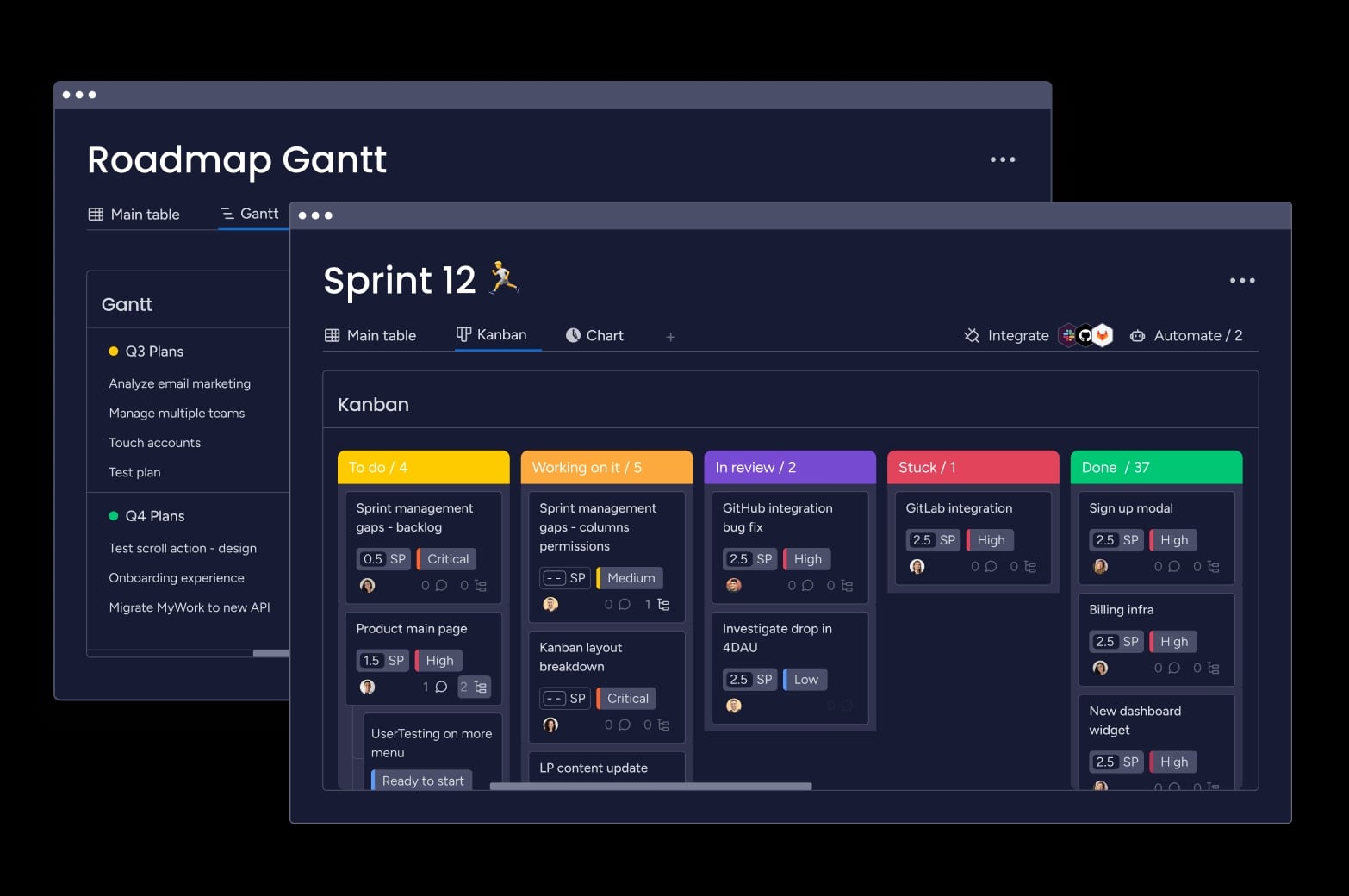
The 12 Agile development principles
These 12 principles from the Agile Manifesto form the foundation for all Agile methodologies. Each one addresses a specific aspect of the Agile SDLC, from customer satisfaction to technical excellence.
1. Customer satisfaction through early and continuous delivery
“Our highest priority is to satisfy the customer through early and continuous delivery of valuable software.”
The first principle highlights why Agile exists in the first place: to keep customers at the centre. Rather than holding back until a complete product is ready, Agile teams deliver smaller, working features on a regular basis. Weekly demos, monthly releases, and continuous integration pipelines all support this steady flow of progress.
Delivering early ensures assumptions are tested before too much time and effort are invested. Continuous delivery keeps customers engaged, builds trust, and opens the door to ongoing feedback that shapes the product as it evolves.
2. Welcome changing requirements for competitive advantage
“Welcome changing requirements, even late in development. Agile processes harness change for the customer’s competitive advantage.”
Change is inevitable, and Agile treats it as an opportunity rather than a setback. Agile planning, regular feedback sessions, and flexible roadmaps make it easier to adapt when new information surfaces.
By welcoming change, teams can respond to shifting customer needs and market conditions faster than competitors locked into rigid plans.
3. Deliver working software frequently
“Deliver working software frequently, from a couple of weeks to a couple of months, with a preference to the shorter timescale.”
Working software is more than tasks marked complete — it’s functional, tested code that delivers real value to customers. Frequent releases create faster feedback loops, reduce the risk of building the wrong features, and keep progress visible.
Agile best practices like continuous integration, Agile testing, and the use of feature flags make it possible to deliver safely and consistently on shorter cycles.
4. Daily collaboration between business and developers
“Business people and developers must work together daily throughout the project.”
Breaking down silos is essential to keeping priorities aligned and avoiding wasted effort. Daily collaboration can take many forms: product managers joining standups, business stakeholders participating in Agile ceremonies, and teams working in shared spaces with full project visibility.
With platforms like monday dev, collaboration becomes seamless as everyone gains the same real-time visibility, staying aligned without the need for constant meetings.
5. Build projects around motivated individuals
“Build projects around motivated individuals. Give them the environment and support they need, and trust them to get the job done.”
This principle is about creating conditions for success, not micromanaging. It outlines the need to provide clear goals, remove obstacles, and trust teams to figure out the best approach.
When teams feel trusted and empowered, they take ownership of results and deliver their best work, especially since employees who understand how success is measured are twice more likely to feel motivated.
6. Face-to-face conversation for effective communication
“The most efficient and effective method of conveying information to and within a development team is face-to-face conversation.”
Direct communication prevents misunderstandings and enables rapid problem-solving. In remote environments, this means video calls and synchronous collaboration rather than endless email chains.
The key is prioritizing real-time, direct communication over written documentation for day-to-day work.
7. Working software as the primary progress measure
“Working software is the primary measure of progress.”
Forget tracking hours logged or items completed. The only metric that matters is functional software that users can interact with.
This focus prevents teams from being “90% done” for weeks and ensures progress measurements reflect actual value delivered.
8. Sustainable development at a constant pace
“Agile processes promote sustainable development. The sponsors, developers, and users should be able to maintain a constant pace indefinitely.”
A sustainable pace ensures teams can work consistently and avoid burnout, leading to higher quality and predictability. Teams plan realistic workloads and protect time for technical maintenance.
Consistency beats intensity. Teams that maintain a sustainable pace deliver more value over time than those that burn out.
9. Technical excellence and good design
“Continuous attention to technical excellence and good design enhances agility.”
Neglecting technical quality creates debt that compounds over time, slowing teams down and making change harder. In contrast, good design and clean code keep systems flexible, allowing teams to adapt quickly when priorities shift.
Excellence is maintained through practices like code reviews, refactoring, automated testing, and thoughtful architectural planning. These investments pay off when speed and flexibility matter most.
10. Simplicity through maximizing work not done
“Simplicity — the art of maximizing the amount of work not done — is essential.”
Simplicity in Agile means focusing on what truly matters and avoiding unnecessary complexity. Instead of building everything at once, teams concentrate on solving the immediate problem with the leanest, most effective solution.
Key practices that support this principle include:
- Deliver only what’s needed to provide customer value right now.
- Avoid speculative features that may never be used.
- Choose the simplest solution that works rather than over-engineering.
- Resist “nice-to-haves” that add clutter without real benefit.
This discipline keeps systems clean, reduces wasted effort, and makes future changes faster and easier.
11. Self-organizing teams for best architecture
“The best architectures, requirements, and designs emerge from self-organizing teams.”
Self-organizing teams decide how to accomplish their work, aligning with Agile roles, rather than following top-down mandates. They have authority and responsibility within defined constraints.
These teams produce superior solutions because they combine diverse perspectives and maintain ownership of their decisions.
12. Regular team reflection and behavior adjustment
“At regular intervals, the team reflects on how to become more effective, then tunes and adjusts its behavior accordingly.”
Reflection happens through retrospectives where teams examine what’s working and what isn’t. The key is turning insights into concrete actions.
This creates a culture of continuous improvement where teams get stronger over time.
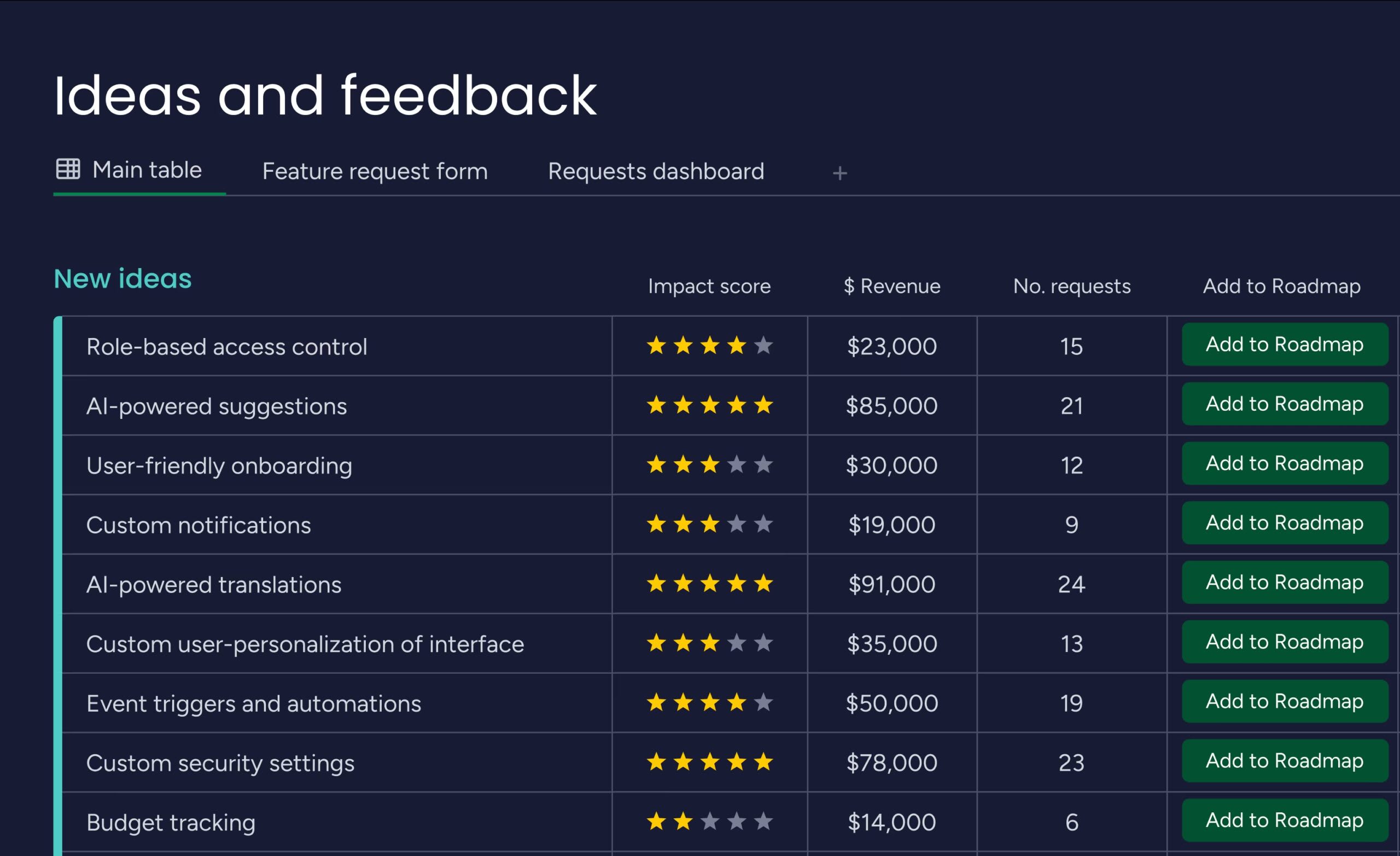
How Agile principles transform development teams
Implementing Agile principles is more than a process change — it’s an Agile transformation that reshapes how teams think, collaborate, and deliver value across the organization. By putting customer outcomes first, embracing adaptability, and fostering seamless collaboration, these principles turn Agile into a culture shift rather than just a methodology.
This transformation is reflected in the way engineering and business teams find alignment, how visibility improves across the product lifecycle, and how teams gain the flexibility to work in the ways that suit them best.
Creating alignment between engineering and business
Engineering and business teams often feel like they’re speaking different languages, which leads to misaligned priorities and wasted effort. Agile principles help bridge this gap by emphasizing customer value, encouraging adaptability, and promoting daily collaboration.
With a shared view of progress in monday dev, both technical and business stakeholders can stay aligned without relying on constant check-ins. This alignment shows up in:
- Shared priorities: everyone is focused on delivering customer value instead of siloed goals.
- Transparent communication: daily collaboration eliminates surprises and reduces misunderstandings.
- Adaptive planning: both teams stay synchronized as conditions and priorities shift.
Building visibility across the product lifecycle
A lack of transparency is one of the biggest challenges in software development. Teams may be working hard, but without clear visibility, stakeholders can’t easily see progress or spot problems until it’s too late. Agile principles address this by building transparency into the process itself.
Frequent delivery demonstrates tangible progress, working software removes ambiguity about project status, and regular reflection drives continuous improvement. Together, these practices create clarity without adding extra layers of bureaucracy.
That level of visibility empowers teams to make faster, more confident decisions and to detect issues early — both of which are critical in fast-moving markets
Enabling flexible Agile practices
Not every team works the same way. Principles five, eleven, and eight give teams freedom to choose their methods while maintaining Agile values.
Whether you use Scrum, Kanban, or create custom Agile workflows on monday dev, the principles focus on outcomes, not prescriptive processes.
Try monday dev5 steps to implement Agile principles successfully
Ready to put these principles into practice? Here’s a systematic Agile strategy that builds capability without overwhelming your team.
Step 1: Assess your current development process
Start by honestly evaluating where you stand today. Ask yourself:
- Do we deliver working software frequently?
- How often do business and development actually collaborate?
- Are our teams empowered to make decisions?
Document both strengths and gaps. This baseline helps you measure progress and prioritize improvements.
Step 2: Identify which principles to prioritize
Don’t try to implement all twelve principles at once. Start with principles that address your biggest pain points.
If customer complaints are high, begin with the first principle (customer satisfaction). If projects constantly miss deadlines, focus on principle three (frequent delivery).
Principles one and seven also make good starting points — they establish customer focus and concrete progress metrics.
Step 3: Build cross-functional team alignment
Getting buy-in requires speaking each audience’s language. Developers care about sustainable pace and technical excellence. Business stakeholders want faster delivery and customer satisfaction.
Show how principles address everyone’s frustrations. Demonstrate how daily collaboration reduces rework. Explain how technical excellence enables faster feature delivery.
Step 4: Create feedback loops and iterations
Establish the infrastructure for Agile principles to work. This means regular demos, retrospectives, and customer feedback sessions.
Start simple — a 15-minute daily standup beats an elaborate ceremony nobody attends. Weekly demos create more value than monthly reports.
Focus on sustainable practices your team will actually use.
Step 5: Measure and adapt your approach
Finally, track outcomes like velocity, customer satisfaction, and team morale. Use both numbers and team feedback to assess progress, leveraging Agile estimation techniques where needed.
Remember, your implementation should be agile too. If something isn’t working, adjust based on results.
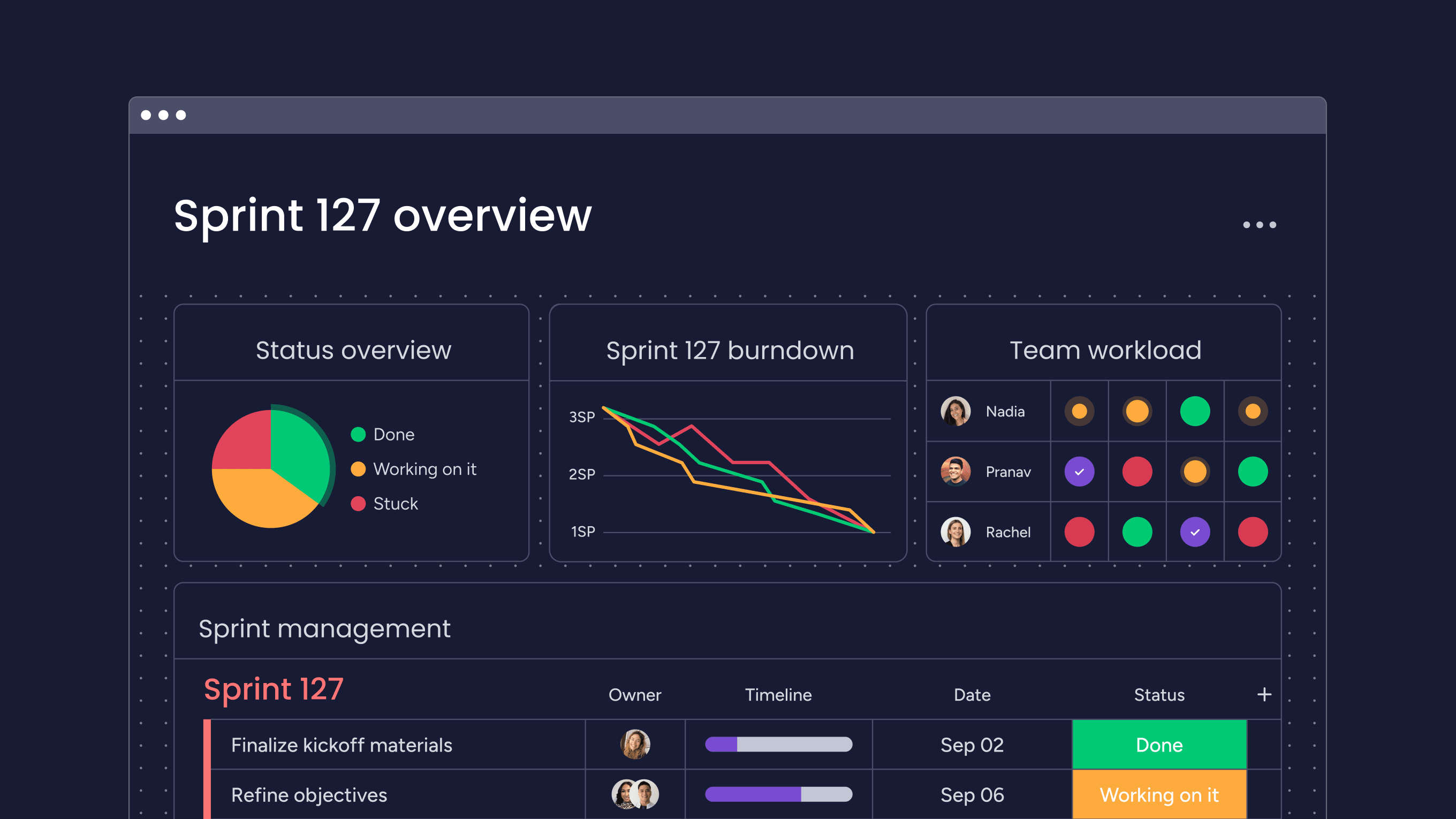
monday dev Testimonials

"monday dev empowered us to optimize our GTM approach, resulting in faster, more dependable deliveries"
Steven Hamrell | Director of Product Management
"monday dev empowers us to manage the entire development process on one platform so we can speed up product delivery and improve customer satisfaction"
Mitchel Hudson | Head of Technology
"We're operating in an open, deep trusting, transparent environment with no silos of information. It's about completely opening access to everyone who needs it."
Alan Schmoll | Executive Vice President, Vistra PlatformCommon challenges when adopting Agile methodology principles
Every team faces obstacles when adopting Agile principles. Knowing what to expect helps you respond effectively.
Overcoming resistance to change
Change is hard, especially when it disrupts comfortable routines. Some team members will resist new approaches.
Build momentum through small wins. Implement one principle successfully before adding others. Share concrete benefits that resonate with sceptics.
Listen to concerns, as resistance often signals legitimate issues. For example, according to the monday World of Work Report, there’s a significant perception gap around change management, with 45% of senior leaders believing it’s handled ‘very well’ compared to just 23% of individual contributors.
Scaling Agile principles across teams
What works for one team might not scale directly to ten teams. Coordination becomes complex when multiple teams need to align.
Adapt practices while maintaining principle intent. Daily collaboration might become regular cross-team syncs. Self-organization might need coordination mechanisms for dependencies.
Focus on outcomes over uniform practices.
Maintaining momentum after initial implementation
Initial enthusiasm often fades as novelty wears off. Without reinforcement, teams drift back to old habits.
Regular retrospectives (principle twelve) helps prevent this drift. Celebrate successes and learn from setbacks to maintain engagement.
Keep principles alive by connecting them to real outcomes and customer impact.
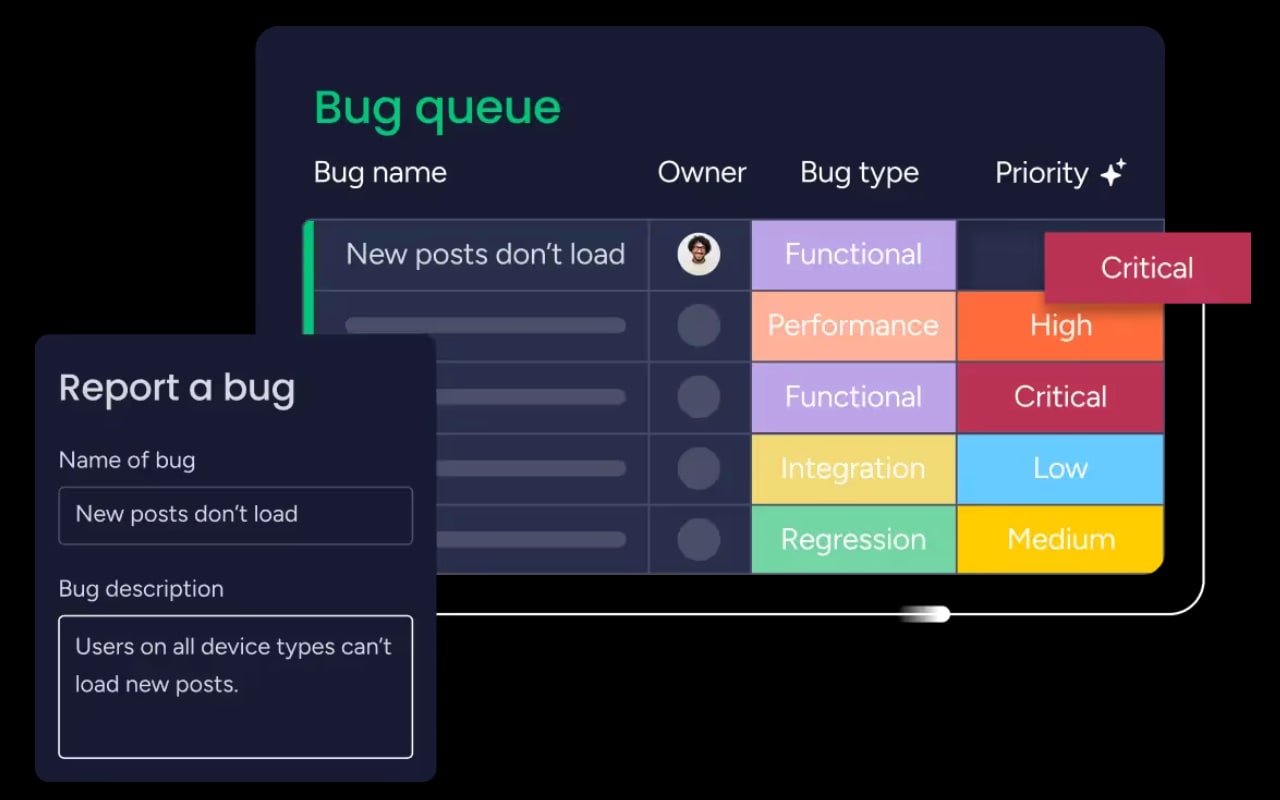
How monday dev empowers teams to live Agile principles
Agile principles are most effective when they’re embedded in the daily rhythm of work. That’s where monday dev comes in. It’s designed to give teams the flexibility, visibility, and insights they need to put Agile into practice — not as an abstract framework, but as tangible habits that drive results.
From empowering team ownership to bridging communication gaps and supporting continuous improvement, monday dev helps development teams turn Agile principles into everyday actions.
Enable team ownership with flexible workflows
Principles five and eleven emphasize motivated individuals and self-organizing teams. monday dev brings these ideas to life by giving teams the flexibility to shape workflows around how they actually work.
Teams can:
- Build boards, automations, and views that reflect their unique approach.
- Define their own “Definition of Done” to clarify what complete really means.
- Establish rules and practices that support their specific way of working.
When people have the freedom to adapt workflows to their context, they feel more ownership of the process — and more motivated to deliver their best work.
Bridge engineering and business through real-time visibility
Principles four and seven require transparent communication between technical and business teams. monday dev provides this visibility without disrupting development flow.
Business stakeholders see sprint progress and potential blockers in real-time. Developers communicate through working software demonstrations and clear status updates.
This transparency eliminates lengthy status meetings while keeping everyone informed.
Support self-organizing teams with AI-powered insights
monday dev’s AI capabilities help teams implement principles nine and twelve by providing data-driven insights for better decisions.
AI identifies bottlenecks, predicts risks, and suggests process improvements based on your team’s patterns. Use these insights during retrospectives to make continuous improvements.
Ready to see how monday dev can help your team implement Agile principles? Try monday dev and experience flexible workflows that adapt to your team’s unique approach to Agile development processes.
Try monday devFrequently asked questions
What are the four core values of the Agile Manifesto?
The four Agile values are individuals and interactions over processes and tools, working software over comprehensive documentation, customer collaboration over contract negotiation, and responding to change over following a plan. Together, these values form the foundation of Agile and are reinforced by the twelve principles that guide teams in their daily work.
How do Agile principles differ from Scrum principles?
Agile principles are the twelve universal guidelines from the Agile Manifesto that apply to all Agile methodologies, while Scrum has its own specific practices like sprints and daily standups. Scrum implements the broader Agile principles through its particular framework and ceremonies.
Which Agile principle should development teams implement first?
Teams should typically start with principle one (customer satisfaction through early delivery) as it establishes the foundation for customer-focused development. This principle naturally leads to implementing other principles like frequent delivery and working software as a progress measure.
Can Agile principles work effectively for remote development teams?
Agile principles work well for remote teams when adapted appropriately, such as using video calls for the face-to-face communication principle and digital collaboration platforms for daily teamwork. The key is maintaining the spirit of the principles while adjusting the specific practices for distributed teams.
What is the most important principle of the Agile methodology?
While all twelve principles work together, principle one (customer satisfaction through early and continuous delivery) is often considered most important because it defines the ultimate goal of Agile development. This principle drives all other practices and decisions in Agile teams.
How long does it take to fully implement all Agile principles?
Most teams take six to twelve months to fully adopt all Agile principles, although they can start seeing benefits from individual principles within weeks. The implementation timeline depends on team size, organizational culture, and how dramatically the principles change existing processes.
 Get started
Get started 


